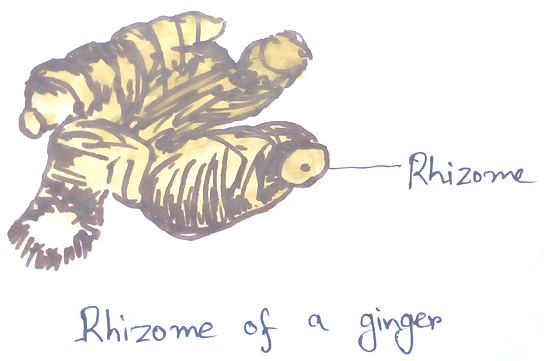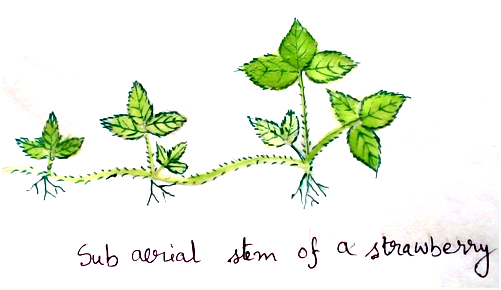Stem and its Modifications
Stem: Stem is the ascending part of the plant axis which develop from the plumule, grows by means of terminal bud and shows differentiation of nodes and internodes. It bears leaves, flowers, fruits and seeds along with buds. Leaf bearing part of the stem is called shoot. Stem branches are exogenous in origin (from surface meristem in the cortex). It is positively phototropic, negatively geotrophic and hydrotrophic.
Stem Branching – Unbranched stems are called caudex or columnar. Caudex with hollow internode or jointed stem is called culm. It is of two types –
Dichotomous branching – It is rarer in angiosperms . The growing part divided into two parts forming two similar branches while the parent axis disappear. Example-Asclepias syriaca.
Lateral branching – The growing point does not divide. Branches are develop from lateral buds lower down from apex. They are of two types –Racemose (Eucalyptus, mustard etc).
Cymose (croton, grapevine).
Types of stem –stems are of three types- reduced (onion, garlic), erect (mango, peepal), weak ( pea, gourd etc).
Function of stem:
1. Stem holds leaves, flowers, fruits,buds, branches of plants.
2. It holds the appendages according to their best position for benefit.
3. It helps in transport of water from roots to the leaves for photosynthesis.
4. On the other hand food produced in leaves is transported to different parts of the plant by vascular bundles called phloem.
5. In some cases stem acts as storage house for some plants. In potatoes starch is stored as food in stem.

Stem modifications:
1. Stem tendril - They may be branched with scale leaves in the region of branching. They are of different kinds . They are –
- Axillary – Example of axillary stem tendrils is Passiflora.
- Extra axillary- Example of extra axillary stem tendrils is Luffa and Cucurbita.
- Scorpioid stem tendrils- example of scorpioid stem tendrils is grapevines
- Floral buds or inflorescence tendrils - Example of inflorescence tendrils is Antigonon.
2. Stem Thorns – They are stiff sharp structures which are formed for reducing transpiration and protection from animals. Thorns are generally axillary. Example- citrus, pomegranate, Bougainville.
Thorns of Duranta bears small leaves, thorns of Alhagi bear flowers,terminal thorns occur in Carissa.
3. Phylloclades – They are green, photosynthetic,often succulent stems of indefinite growth. It is an adaptation for dry habitats. The leaves are caducous. Example of phylloclades are Opuntia, Cocoloba etc. In opuntia each segments or phylloclades is a branch that arises in the axil of caducous leaf and possesses raised areas or areoles representing nodes. An areole has a leaf scar, one two spines and a number of stiff hair called bristles or glochidia.
4. Cladodes - they are also called cladophyls. They are green photosynthetic stems of limited growth (generally one internode long) with leaves reduced to scales or modified into spines. Example of cladodes are –
In Asparagus the cladodes develop in cluster which are straight or curved, slightly flattened, pointed fleshy structures. Cladodes of Ruscus are leaf like borne in the axis of scales leaves.
5. Underground stem takes part in perennation and vegetative multiplication (potato).
From Stem and its Modifications to HOME PAGE
Recent Articles
-
What Is Plasma? | Blood Plasma | Proteins | Nutrients | Cholesterol
Nov 07, 25 10:29 AM
Blood is a mobile fluid which is a connective tissue and is derived from the mesoderm like cell any other connective tissue. Colour of blood is reddish and that flows inside the blood vessels by means… -
Disorders of Respiratory System | Tuberculosis | Pleurisy | Emphysema
Oct 28, 25 11:39 PM
Tuberculosis is very common disease and is caused by a type of bacteria called Mycobacterium tuberculosis. This disease causes different trouble in the respiration and infection of several parts of th… -
Regulation of Respiration | Respiratory Centres | Inspiratory Area |
Oct 14, 25 12:13 AM
Respiratory Centre is the area that controls the rate of respiration and it is observed to be located in medulla oblongata and pons. Respiratory Centre has the following will dispersed components like… -
Explain Transport of Gases | External Respiration | Tissue Respiration
Oct 09, 25 11:35 PM
In humans gaseous exchange is completed in the following ways the steps are - External Respiration or Breathing - Breathing in false taking in of Oxygen and giving out of carbon dioxide in the body. M… -
Kind and Number of Teeth | Location of Teeth in Mouth | Care of Teeth
Sep 11, 25 12:52 AM
Kind and Number of Teeth






New! Comments
Have your say about what you just read! Leave me a comment in the box below.